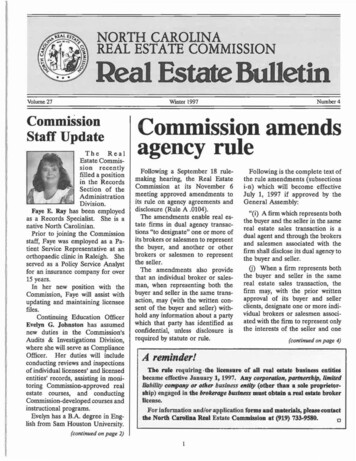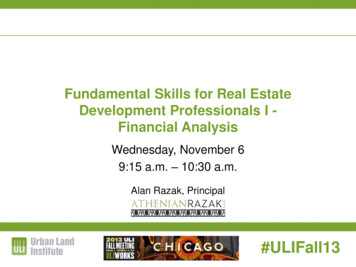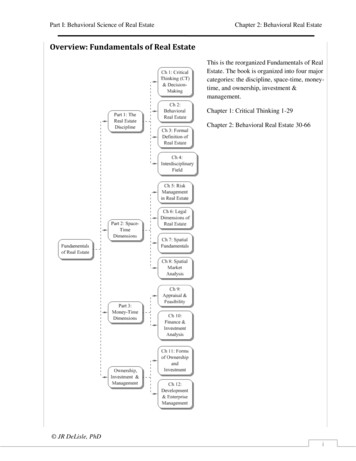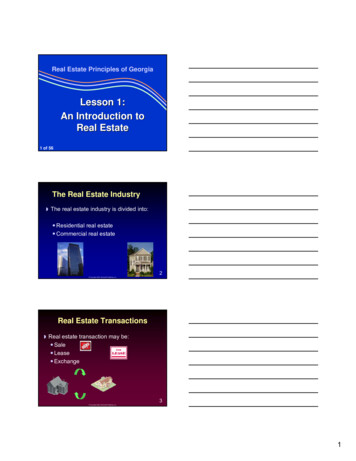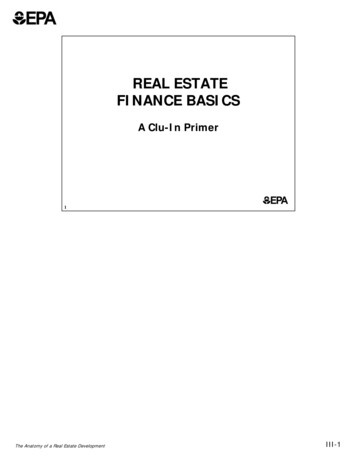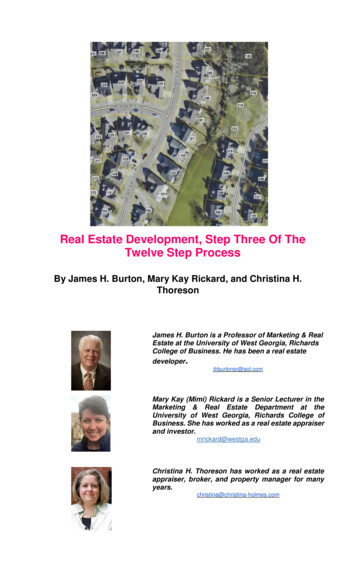
Transcription
Real Estate Development, Step Three Of TheTwelve Step ProcessBy James H. Burton, Mary Kay Rickard, and Christina H.ThoresonJames H. Burton is a Professor of Marketing & RealEstate at the University of West Georgia, RichardsCollege of Business. He has been a real estatedeveloper.jhburtonsr@aol.comMary Kay (Mimi) Rickard is a Senior Lecturer in theMarketing & Real Estate Department at theUniversity of West Georgia, Richards College ofBusiness. She has worked as a real estate appraiserand investor.mrickard@westga.eduChristina H. Thoreson has worked as a real estateappraiser, broker, and property manager for manyyears.christina@christina-holmes.com
AbstractThis article focuses on some simple techniques of how to complete a preliminarymarket feasibility study in a proposed residential real estate development. The twelvesteps in real estate development are reviewed with special emphasis on step three: thepreliminary market feasibility, which is an important step in determining the financialfeasibility of the proposed real estate development. The feasibility analysis requiresspecific analyses of existing and proposed developments that will likely compete withthe proposed development; this is termed a competitive survey. A specific analysis ofpopulation demand is also required. This article explains in simple terms how tomeasure and estimate housing demand, compared to the existing and planned housingsupply.IntroductionFifteen years ago, an article was published in B-QUEST about real estatedevelopment that received far more attention than was expected. The article was titled“Residential Real Estate Development”, and was published by B Quest(https://www.westga.edu/ bquest/2000/resident.html), the online business journal of theUniversity of West Georgia. The initial article described in simple terms how to developa residential subdivision from the idea to the final phase of marketing and selling. Theauthor has personally used this development process in the past, and he distilled theprocess into the twelve steps listed below.1.2.3.4.5.6.7.8.9.10.11.12.Create the development ideaSecure the vacant site or undeveloped landComplete a preliminary market feasibility studyHave the preliminary plans and specifications drawnObtain a mortgage financing commitmentCause the final market feasibility study to be completedComplete the engineering final plans and specificationsEstimate the final total costs, direct and indirectComplete a discounted cash flow analysisAnalyze various risks associated with the proposed developmentBegin actual construction of the streets, utilities, and lotsCreate a marketing and selling plan and sell the lotsIn land development, it is important to understand which things are changeable(our plans) and which are not (the market). The first part of that process isunderstanding what market conditions exits.After receiving numerous comments and requests for development consultingsince the article’s publication in 2000, there seemed to be a need for more informationon this topic. Therefore, the article’s central purpose is to focus on a single part of theresidential real estate development process: Step 3 - how to complete a preliminarymarket feasibility study.After the developer has an idea and has executed an option agreement or acontract to purchase the site, he/she must complete a preliminary market feasibilitystudy. In most cases, an independent real estate expert is hired to complete it. Thestudy involves the research and analysis of supply based on an investigation ofcompeting single-family residential developments in the market area, and demandbased on population demographics.
In a market feasibility analysis, first we define a market area or trade area for theproposed subdivision. Several simple ways to define the residential market area are bycounty, city, or zip code; however, with new demographic analysis computer programs,for example, the Site To Do Business (STDB.com), trade areas using driving time orphysical boundaries such as roads or rivers can also be used to define markets.Competitive Survey of SupplyThe market analyst must consider the existing and planned supply ofcompetition for the proposed development in the defined market area. For existingsupply, the analyst should tour the area to inspect the competing subdivisions in thedefined market or trade area. For planned supply, a visit to the planning office iswarranted, and an evaluation of the possibility those planned developments will beapproved should be made.Once the existing competing subdivisions have been identified, the analyst mustreview the sales data to determine the prices and absorption levels of lots in thosecompeting subdivisions. In Georgia, most sales data is available easily online from eachCounty Tax Assessor's office. The sales data from the county can be saved onto aspreadsheet program, which can be sorted according to vacant lot and improved housesales. Below is a sample spreadsheet of improved house sales from the Turtle PointSubdivision in Carroll County Georgia.The improved house sales were extracted from the Carroll County TaxAssessor’s office data online. They are then modified to show the simplified pertinentdata.The following are vacant lot sales extracted from the County Tax Assessor’s website online. These lot sales were from 2002 to 2010 in a large subdivision called FairfieldPlantation, which is located in the northern part of Carroll County, Georgia. The datawas saved in spreadsheet format for easy analysis. Note the average lot price was 12,600 (rounded), and the average price per square foot of land area was 0.82.
Also take note of the distribution of lot sales each 22003020022
The individual parcel details can be reviewed online at the County TaxAssessor’s web site. Each parcel record includes ownership information, floor plansketches, site plan, construction features, and sales history. An individual parcelexample is shown below.Note that the top banner of the Tax Assessors’ individual parcel page has a linkwhere you could click on “Recent Sales in Neighborhood” or “Recent Sales in Area.”Under the owner and parcel information includes, the owner’s address, utilities availableto the subject site, the tax parcel number, and the number of acres or lot size. This pagealso has a link to “Show Parcel Map”; if you click on the “Show Parcel Map” link, a platof the subject parcel will appear, like the aerial plat below.
The next block is the “Tax Year Value Information” for 2015, which shows the taxassessors’ estimate of the land value, the improvement value, and the total value.Although tax assessors typically use mass appraisal techniques, their estimate ofmarket value should be within 90% to 110% of the fair market value of the property. Ofcourse this range may vary by location.There is also a section entitled “Improvement Information,” which describes thetype of construction, the square footage of the house or building, the date built, rooftype, flooring type, heating and air conditioning type, and number of rooms, bedroomsand bathrooms. Additionally, this section has a link to “Sketch Building"; if you click onthe “Sketch Building” link, a floor plan of the subject building will appear, like the planbelow.The last section of the individual parcel, “Sales Information” shows the parcel’ssales history. This may be important when analyzing specific sales data and makingrelative time comparisons.
For proposed supply, the local planning authorities should be contacted todiscover any undeveloped subdivisions that have been approved for development,evaluate the likelihood of approval, and consider the time frame for those lots/houses tobe available to the market and compete with the subject development. Another indicatorof supply is the number of single-family and multifamily residential building permitsissued monthly and annually for the past several years. Typically these are alsoavailable through the County or municipality (city) planning department. Then, theanalyst should compare the total existing competing developments plus the proposedsubdivision developments with the forecasted demand for single-family lots and homeswithin the defined market area.1Estimating Preliminary DemandAn accurate preliminary demand analysis is critical to the market feasibility ofany development. For a proposed single-family subdivision, the number of existinghouseholds in the market area should be estimated, and the expected or forecastedgrowth of the number of households during each of the next five years should beestimated. This data is readily available from local planning agencies and many onlinedata sources such as STDB.com, ESRI Demographics, Neighborhoodlink.com, U.S.Census data, State and National Departments of Labor, etc. In addition to the number ofexisting and forecasted households in the market area, the annual income distributionwithin the market area per household is important. Such information reveals the incomeavailable for housing expenses, and hence, the likely price ranges of lots and homes inthe proposed subdivision. Below is a sample page from ESRI on Forsyth County inGeorgia.1For further information, there is a book Market Analysis for Real Estate, by Stephen F. Fanning, MAIavailable through The Appraisal Institute which may be helpful for further technical aspects of this typeanalysis.
Note that the number of households in this county is expected to grow from68,786 in 2015 to 80,830 in 2020, an increase of 12,044 households during the fiveyearperiod, or an average increase of 2,408 households each year. The estimated increasein households can be refined further by the distribution of household incomes. Forexample, assume that the proposed subdivision has expected sales prices of homesranging from 250,000- 300,000, typical mortgage terms are 80% loan-to-value ratio,and 5% interest for a 30 year fully amortized term, and typical housing cost ratio is 25%of monthly income. These assumptions suggest annual income levels need to bebetween 52,000 and 62,000 to afford new homes in our proposed subdivision. 250,000- 300,000 x 200,000 - 240,00080% x 200,000 - 240,0000.064419 (mortgage constant) 12,884 to 15,461 annual mortgage payments 12,844 - 15,461 / 25% 51,376 to 61,844 annual income requiredLooking at the above ESRI demographic chart, it is noted only 13.1% ofhouseholds in this county range from 50,000- 75,000 income per year. Assuming that
the higher income levels would purchase more expensive houses, this would suggestthat the total market capture rate for the households in our county would be 315households per year (2,408 households * 13.1%). Let's also assume typical distributionbetween renters and homeowners in our local market is 70% homeowners and 30%renters; hence, our 315 households potentially demanding our produce would be furtherreduced by allocating 220 households per year to ownership versus renters. Thisestimate would be divided among all of the competing developments in our pricerange in this county or market area.Demand and Supply ConclusionsIf the forecasted quantity of demand exceeds the existing and projected quantitysupplied, the preliminary market feasibility study would indicate potential success for theproposed development. Of course, if the existing and proposed competingdevelopments available exceed the forecasted demand, then the developer should notpursue the development of this new single-family subdivision as proposed.For example, assume that there are three competing residential developments inour price range of 250,000 to 300,000. Also, assume that these three competingdevelopments have sold a total of 50 lots and houses during the past three years;however, they have another 250 additional lots available for sale; hence, there are 200lots unsold which will need to be absorbed in the future. Also assume that there are twoadditional subdivision developments planned and approved for development by the localplanning board; one subdivision has a proposed and approved 150 lots and the othersubdivision has a proposed and approved 135 lots.Now let's compare the existing supply of competing lots in the area with theestimated demand for new lots and homes in the area. The three existing competingdevelopments have sold 50 lots over the last three years, or approximately 16 lots peryear. The existing developments have 200 lots remaining to be sold, and there are anadditional 285 lots approved to be developed. Therefore, the total competition is 485lots. Let's also assume that my development has 65 lots proposed. Combining theavailable lots, approved lots, and my development, which is a total of 550 lots.If we consider 220 households are in our development’s income bracket andprice range in the county each year, one way to allocate those purchases is a directpercentage of each development to the total count.Number of Lots PercentageCapturePotentialHouseholds/lotsales200 Lots unsold 36.6%81ApprovedSubdivision150 lots27.2%60ApprovedSubdivision135 lots24.5%54Our subdivision65 lots11.8%26Total Market550 lots100.1%*221*Existing subdivision* (not exact due to rounding)
The proposed subdivision must capture 11.8% of the market to compete. Thiswould mean a sellout of the project estimated in 2.6 years (25 sold per year of 65 totallots) assuming no new competing development occurs. There would be costs ofinterest, taxes, maintenance, marketing, selling commissions, and other items duringthat period while the lots were selling.The primary point here is the developer, lender, and appraiser should complete arelatively thorough preliminary market analysis. This analysis would compare thenumber of competing developments and lots with the number of new households livingin the area who have the money available to buy homes in the subject’s proposeddevelopment and the competing developments in the defined area.Some Prob
1 For further information, there is a book Market Analysis for Real Estate, by Stephen F. Fanning, MAI available through The Appraisal Institute which may be helpful for further technical aspects of this type analysis. Note that the number of households in this county is expected to grow from 68,786 in 2015 to 80,830 in 2020, an increase of 12,044 households during the fiveyear period, or an .

